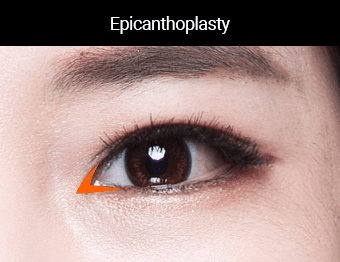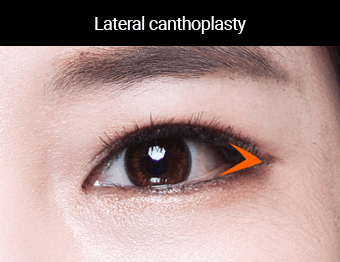
Epicanthoplasty – Inner Eyelid Surgery
For Wider & Bigger Looking Eyes.
Enhance The Shape Of Your Eyes!

Procedure Time
30 – 50 Minutes

Anaesthesia
Light Sedation

Recovery Period
7 – 10 Days

Stitch Removal
7 Days Post-op
What Is Epicanthoplasty?
Epicanthoplasty (Inner Eyelid Surgery) is a procedure that helps to widen the width of the eyes and make them look more open and bigger by extending the inner and outer corners of the eye. This procedure also helps enhance the proportion of the width of the eyes in relation to your face.
The Epicanthic fold (also known as Mongolian fold) is the upper eyelids’ skin, which covers the inner corner of the eyes. The downfalls to the skin fold covering the inner corner of the eyes include:
- It causes the eyes to look wide than they actually are
- The shape of the eyes looks undefined
- Eyes can appear smaller
The Epicanthoplasty corrects the Epicanthic fold of the eyes. The procedure involves tiny incisions on the inner corner of the eyes. It helps to get rid of excess skin, and the results are more prominent, brighter eyes, and natural-looking eyes.
Types of Epicanthoplasty
There are two types of epicanthoplasty procedures, and each type elongates a specific side of the eye. Depending on the shape of your eye, as well as your existing proportions, you may be recommended one or both types of epicanthoplasty.
Medial Canthoplasty
Medial Canthoplasty corrects the epicanthus fold, the excess skin at the inner corners of the eye, which can sometimes make a person look less friendly. This procedure elongates the eyes towards the center of the face, bring wide set eyes closer.


Epicanthoplasty
- Those who wish to enlarge small and narrow eyes
- Bringing wide-set eyes closer to the center of the face
- Those who want to enhance the shape of the eye
- Those who need to remove excess skin on the inner corners of the eye to transform tapered to parallel double eyelids

Lateral Canthoplasty
- Those who wish to enlarge small and narrow eyes
- Those who prefer an elongated eye shape
Epicanthoplasty Procedure Steps
Medial canthoplasty Procedure Steps
Before the surgery, the length and the severity of the epicanthal fold is measured during the pre-surgical evaluation process called “customized design.” The surgeon then calculates how wide your inner eyelids will be excised and marks the area with the pen. Local anesthesia is given around the eyes to eliminate painful sensations.
By creating small flaps through the incisions, the surgeon uses the pen marks to restructure the inner eyelid’s shape. Excess skin, fat, and muscle are removed during the process. After the epicanthal fold is successfully reoved, sutures are used to close the incision.

Lateral Canthoplasty Steps
Lateral Canthoplasty procedure is performed with the same methods as medial canthoplasty, except that incisions are made on the conjunctival line (outer corner of the eyes). The lateral epicanthus fold is removed that results in bigger, longer, and vivid eyes.

Frequently Asked Questions (FAQ) about Epicanthoplasty
What Should I Take Note Of Before The Procedure?
To decrease the odds of any complexities during procedure, those undergoing surgery are encouraged to avoid smoking and alcohol for 2 weeks prior to the surgery and after the procedure.
The plastic surgeon should be informed of any long-term medication you are currently taking as you may be required to make adjustments before the procedure. As with all surgery procedures, aspirins, blood thinning medication and certain types of supplements should be stopped prior to your procedure to avoid excessive bleeding or unwanted side effects.
What Should I Take Note Of After The Procedure?
Medication and specific instructions for wound care will be advised. You are also recommended to rest with your head elevated above your heart level to help with post-surgery swelling.
The surgeon may advise you to avoid contact lenses for the initial 2 weeks after the procedure to facilitate wound healing. Eye cosmetics and other similar products are also prohibited to use for the first 2 weeks or as recommended by the plastic surgeon.
Abstain from putting any force near your eyes (tugging or pulling of eyelid skin) until the wound has recovered. This may take as long as half a month depending on each patient’s recovery.
How Long Can You See The Results Of Epicanthoplasty Surgery?
There is likelihood that you will not see the complete results right after the epicanthoplasty procedure due to post-surgery swelling. Results will be more noticeable two to three weeks after the procedure since swelling would have has subsided by 80% to 90% during that time. The remaining swelling will take a longer time to subside and final results is expected 6 months after your procedure.
Is There Any Downtime?
Slight to moderate swelling and bruising near the eyes is normal after the operation and will subside in around 10 to 14 days. You may encounter some discomfort in the eye during the initial recovery stage and it should subside in the next couple of days. Eye drops may be prescribed to ease the discomfort. Most people are able to return to their daily activities after a week.
How Is Recovery Like After Epicanthoplasty Surgery?
Swelling and bruising may cause some pain or discomfort which is easily controlled by oral medication. Stitches are removed 7 days after the procedure and you should apply topical antibiotic ointment over the wounds for the initial ten days. After that you can begin wearing eye makeup and this can adequately cover the remaining redness and bruises so you do not have to wear shades to hide your eyes. Exercise regime can be continued three weeks after the procedure.
